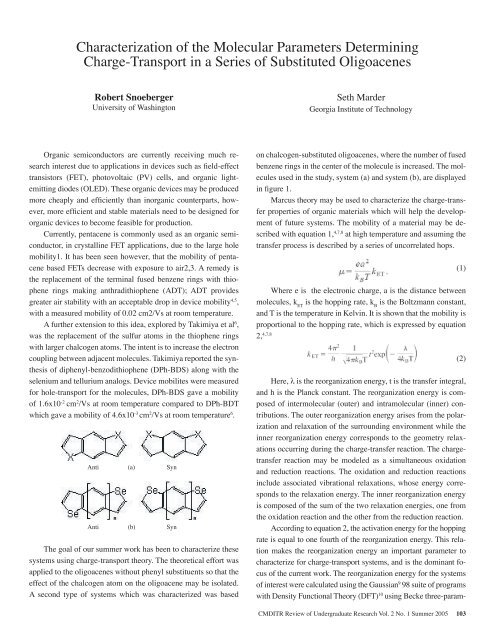Student Project Abstracts 2005 - Pluto - University of Washington
Student Project Abstracts 2005 - Pluto - University of Washington
Student Project Abstracts 2005 - Pluto - University of Washington
Create successful ePaper yourself
Turn your PDF publications into a flip-book with our unique Google optimized e-Paper software.
Characterization <strong>of</strong> the Molecular Parameters DeterminingCharge-Transport in a Series <strong>of</strong> Substituted OligoacenesRobert Snoeberger<strong>University</strong> <strong>of</strong> <strong>Washington</strong>Seth MarderGeorgia Institute <strong>of</strong> TechnologyOrganic semiconductors are currently receiving much researchinterest due to applications in devices such as field-effecttransistors (FET), photovoltaic (PV) cells, and organic lightemittingdiodes (OLED). These organic devices may be producedmore cheaply and efficiently than inorganic counterparts, however,more efficient and stable materials need to be designed fororganic devices to become feasible for production.Currently, pentacene is commonly used as an organic semiconductor,in crystalline FET applications, due to the large holemobility1. It has been seen however, that the mobility <strong>of</strong> pentacenebased FETs decrease with exposure to air2,3. A remedy isthe replacement <strong>of</strong> the terminal fused benzene rings with thiophenerings making anthradithiophene (ADT); ADT providesgreater air stability with an acceptable drop in device mobility 4,5 ,with a measured mobility <strong>of</strong> 0.02 cm2/Vs at room temperature.A further extension to this idea, explored by Takimiya et al 6 ,was the replacement <strong>of</strong> the sulfur atoms in the thiophene ringswith larger chalcogen atoms. The intent is to increase the electroncoupling between adjacent molecules. Takimiya reported the synthesis<strong>of</strong> diphenyl-benzodithiophene (DPh-BDS) along with theselenium and tellurium analogs. Device mobilites were measuredfor hole-transport for the molecules, DPh-BDS gave a mobility<strong>of</strong> 1.6x10 -2 cm 2 /Vs at room temperature compared to DPh-BDTwhich gave a mobility <strong>of</strong> 4.6x10 -3 cm 2 /Vs at room temperature 6 .Anti (a) SynAnti (b) SynThe goal <strong>of</strong> our summer work has been to characterize thesesystems using charge-transport theory. The theoretical effort wasapplied to the oligoacenes without phenyl substituents so that theeffect <strong>of</strong> the chalcogen atom on the oligoacene may be isolated.A second type <strong>of</strong> systems which was characterized was basedon chalcogen-substituted oligoacenes, where the number <strong>of</strong> fusedbenzene rings in the center <strong>of</strong> the molecule is increased. The moleculesused in the study, system (a) and system (b), are displayedin figure 1.Marcus theory may be used to characterize the charge-transferproperties <strong>of</strong> organic materials which will help the development<strong>of</strong> future systems. The mobility <strong>of</strong> a material may be describedwith equation 1, 4,7,8 at high temperature and assuming thetransfer process is described by a series <strong>of</strong> uncorrelated hops.Where e is the electronic charge, a is the distance betweenmolecules, k ETis the hopping rate, k Bis the Boltzmann constant,and T is the temperature in Kelvin. It is shown that the mobility isproportional to the hopping rate, which is expressed by equation2, 4,7,8 (2)Here, λ is the reorganization energy, t is the transfer integral,and h is the Planck constant. The reorganization energy is composed<strong>of</strong> intermolecular (outer) and intramolecular (inner) contributions.The outer reorganization energy arises from the polarizationand relaxation <strong>of</strong> the surrounding environment while theinner reorganization energy corresponds to the geometry relaxationsoccurring during the charge-transfer reaction. The chargetransferreaction may be modeled as a simultaneous oxidationand reduction reactions. The oxidation and reduction reactionsinclude associated vibrational relaxations, whose energy correspondsto the relaxation energy. The inner reorganization energyis composed <strong>of</strong> the sum <strong>of</strong> the two relaxation energies, one fromthe oxidation reaction and the other from the reduction reaction.According to equation 2, the activation energy for the hoppingrate is equal to one fourth <strong>of</strong> the reorganization energy. This relationmakes the reorganization energy an important parameter tocharacterize for charge-transport systems, and is the dominant focus<strong>of</strong> the current work. The reorganization energy for the systems<strong>of</strong> interest were calculated using the Gaussian 9 98 suite <strong>of</strong> programswith Density Functional Theory (DFT) 10 using Becke three-param-(1)CMDITR Review <strong>of</strong> Undergraduate Research Vol. 2 No. 1 Summer <strong>2005</strong> 103




